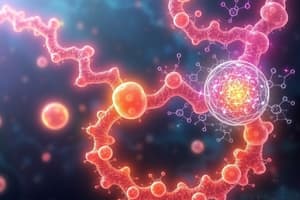Podcast
Questions and Answers
Which of the following amino acids is NOT capable of undergoing transamination?
Which of the following amino acids is NOT capable of undergoing transamination?
- Lysine
- Threonine
- Glutamine (correct)
- Proline
Which enzyme is specific and presents clinical diagnostic importance due to its presence in most tissues?
Which enzyme is specific and presents clinical diagnostic importance due to its presence in most tissues?
- Superoxide dismutase
- Alanine transaminase (ALT, or GPT) (correct)
- Glutathione peroxidase
- Catalase
Which coenzyme is required for transaminases to catalyze transamination reactions?
Which coenzyme is required for transaminases to catalyze transamination reactions?
- Coenzyme Q10
- NAD+
- Pyridoxal phosphate (PLP) (correct)
- FAD
Where does transamination mainly occur?
Where does transamination mainly occur?
Which process involves the reversible transfer of an amino group from an α-amino acid to an α-keto acid?
Which process involves the reversible transfer of an amino group from an α-amino acid to an α-keto acid?
Which enzyme catalyzes the transfer of amino group from aspartate to α-ketoglutarate to form glutamate and oxaloacetate?
Which enzyme catalyzes the transfer of amino group from aspartate to α-ketoglutarate to form glutamate and oxaloacetate?
What is the normal plasma level of Alanine transaminase (ALT) or glutamate-pyruvate transaminase (GPT)?
What is the normal plasma level of Alanine transaminase (ALT) or glutamate-pyruvate transaminase (GPT)?
Which type of deamination involves the removal of hydrogen sulfide (H2S)?
Which type of deamination involves the removal of hydrogen sulfide (H2S)?
What is the specific function of D-amino acid oxidase?
What is the specific function of D-amino acid oxidase?
What is transamination?
What is transamination?
Which enzyme allows the transfer of hydrogen from the L-amino acid to molecular O2 with formation of H2O2?
Which enzyme allows the transfer of hydrogen from the L-amino acid to molecular O2 with formation of H2O2?
What are the three specific transaminases with clinical diagnostic importance?
What are the three specific transaminases with clinical diagnostic importance?
Where does transamination mainly occur?
Where does transamination mainly occur?
What is the diagnostic importance of transaminases?
What is the diagnostic importance of transaminases?
What is the function of transaminases or aminotransferases?
What is the function of transaminases or aminotransferases?
What is the normal plasma level for Alanine transaminase (ALT) or glutamate-pyruvate transaminase (GPT)?
What is the normal plasma level for Alanine transaminase (ALT) or glutamate-pyruvate transaminase (GPT)?
Which amino acids are not transaminable?
Which amino acids are not transaminable?
Where is Aspartate transaminase (AST) present?
Where is Aspartate transaminase (AST) present?
What is the site for 2-Deamination, the removal of amino groups from amino acids as free ammonia (NH3)?
What is the site for 2-Deamination, the removal of amino groups from amino acids as free ammonia (NH3)?
Name the three oxidative deaminases involved in the reversible removal of the amino group as ammonia secondary to dehydrogenation of the amino acid.
Name the three oxidative deaminases involved in the reversible removal of the amino group as ammonia secondary to dehydrogenation of the amino acid.
What is the specific function of L-amino acid oxidase?
What is the specific function of L-amino acid oxidase?
What type of deamination involves the addition of water?
What type of deamination involves the addition of water?
Which enzyme catalyzes the transfer of amino group from aspartate to α-ketoglutarate to form glutamate and oxaloacetate?
Which enzyme catalyzes the transfer of amino group from aspartate to α-ketoglutarate to form glutamate and oxaloacetate?
Name the type of deamination combined with removal of hydrogen sulfide (H2S).
Name the type of deamination combined with removal of hydrogen sulfide (H2S).
What is the reversible removal of the amino group as ammonia secondary to dehydrogenation of the amino acid called?
What is the reversible removal of the amino group as ammonia secondary to dehydrogenation of the amino acid called?
What is the coenzyme required for transaminases to catalyze transamination reactions?
What is the coenzyme required for transaminases to catalyze transamination reactions?
Flashcards are hidden until you start studying
Study Notes
Amino Acid Metabolism
- Proline is not capable of undergoing transamination.
- Aspartate transaminase (AST) is an enzyme specific to most tissues and has clinical diagnostic importance.
- The coenzyme required for transaminases to catalyze transamination reactions is Pyridoxal phosphate (PLP).
- Transamination mainly occurs in the liver and kidneys.
Transamination Reaction
- Transamination involves the reversible transfer of an amino group from an α-amino acid to an α-keto acid.
- The enzyme that catalyzes the transfer of an amino group from aspartate to α-ketoglutarate to form glutamate and oxaloacetate is aspartate transaminase (AST).
Diagnostic Importance
- The normal plasma level of Alanine transaminase (ALT) or glutamate-pyruvate transaminase (GPT) is 0-40 IU/L.
- Transaminases have clinical diagnostic importance due to their presence in most tissues.
Deamination
- Desulfhydration is a type of deamination that involves the removal of hydrogen sulfide (H2S).
- The specific function of D-amino acid oxidase is to catalyze the deamination of D-amino acids.
- L-amino acid oxidase is the enzyme that allows the transfer of hydrogen from the L-amino acid to molecular O2 with formation of H2O2.
- The site for 2-Deamination, the removal of amino groups from amino acids as free ammonia (NH3), is the liver.
- The three oxidative deaminases involved in the reversible removal of the amino group as ammonia secondary to dehydrogenation of the amino acid are L-amino acid oxidase, D-amino acid oxidase, and Glutamate dehydrogenase.
Transaminases
- The function of transaminases or aminotransferases is to catalyze transamination reactions.
- The three specific transaminases with clinical diagnostic importance are Aspartate transaminase (AST), Alanine transaminase (ALT), and Glutamate-pyruvate transaminase (GPT).
- The amino acids that are not transaminable are Proline and Hydroxyproline.
Studying That Suits You
Use AI to generate personalized quizzes and flashcards to suit your learning preferences.




